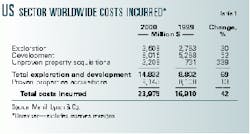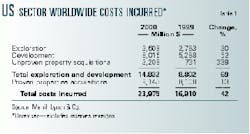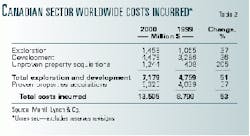North American oil and gas companies' finding costs reached a 3-year high last year, and costs are likely to rise again this year, Merrill Lynch & Co. stated in a recent report.
"Finding costs could rise in 2001. In our view, that occurrence won't matter in a period of higher operating margins, but the market still remains unconvinced that higher prices are here to stay," the report said. "In our view, the business has normalized back to more full-cycle economics."
Merrill Lynch analyzed finding cost results for 59 companies-37 US firms and 22 based in Canada-during the last 15 years.
"Total worldwide costs incurred increased to $37.5 billion in 2000 from $25.7 billion in 1999," for all the companies that were considered, the report said. Costs increased across the board: acquisition costs jumped by $3.3 billion, or an increase of more than 27%, while exploration and development capital expenditures climbed 62% to $22 billion, the report said.
"Worldwide revised, all-sources finding costs for the 59 E&P [companies] were $1.02/[Mcf of gas equivalent] [$6.12/boe]," the report said, adding that the finding costs were the same for the entire study group overall, for the US sector, and for the Canadian sector.
All-sources finding costs are the total expensed and capitalized costs incurred for exploration, development, and property acquisitions (proven and unproven) divided by the added oil or gas-equivalent reserves (from revisions, extensions, discoveries, acquisitions, and enhanced recovery).
Reserve revisions are engineered changes stemming from additional production, geologic information, and price changes. Revisions help adjust for the time-lag nature of booking reserves.
Finding costs mounting
For all 59 companies worldwide, revised all-sources finding costs were up 29% in 2000. "Between the 1987 spending low and 2000, exploration expenses have risen 6.2 times, development outlays were up 9 times, proven reserves acquisitions expenditures were up 56.7 times, and unproven acreage expenditures have risen 15.1 times," the report said.
The largest reserve additions came from field extensions and discoveries, although in 2000, proven property acquisitions were 41% of reserves additions, which was the second-highest level on record.
Natural gas additions have increased by 14.9 times since 1987 and, in 2000, were 57% of net, worldwide energy-equivalent reserve additions. Oil additions have risen 10 times since 1987.
Revised, all-sources finding costs dropped 18% from 1987 to 1996, to 76¢/Mcfge; rose to $1.15/Mcfge by 1998; fell to 79¢/Mcfge in 1999; and bounced back to $1.02/Mcfge in 2000.
"We don't expect finding costs to remain at 2000 levels long term, becauseellipse the industry will ultimately have to explore again and get away from high-POS [probability of success] exploitation plays," the report said.
Barring any second-half 2001 mergers, Merrill Lynch expects total E&D costs for the sector to increase 15-25% as companies use increased discretionary cash flow.
US sector
For the US sector, worldwide revised, all-sources unit finding costs were up 33% in 2000 to $1.02/Mcfge. The E&D costs were 57% higher, while acquisitions costs were 6% higher.
"Finding costs have hit an upward inflection pointellipsewe're not surprised, and we believe that the industry might have to get used to thinking of [$1/Mcfge] as a low," the report said (Table 1).
During 2000, the prime sources of proven reserves acquisitions for US-based E&P firms were Houston-based Anadarko Petroleum Corp., Apache Corp., and Newfield Exploration Co.; Oklahoma City-based Devon Energy Corp., Kerr McGee Corp., and Louis Dreyfus Natural Gas Corp.; and Unocal Corp., El Segundo, Calif.
The 37 US companies included 10 large companies, 13 midsized companies, and 14 small companies.
"On an energy-equivalent basis, US reserves additions were up 7% to 23.4 tcfe and were the highest over the 15 years. Natural gas represented 60% of the total energy-equivalent additionsellipseLike the 59-company sector, the results reflected the industry's focus on North American natural gas," the report said.
Since the US sector's worldwide spending lows of 1987, costs have risen by a multiple of 9.8 to a record $24 billion in 2000, the report said.
Revised, all-sources finding costs dropped 32% during 1986-96 to 74¢/Mcfge, rose to $1.32/Mcfge by 1998, fell to 77¢/Mcfge in 1999, and then rebounded to $1.02/Mcfge in 2000.
Energy-equivalent unit acquisitions costs were 82¢/Mcfge in 2000 compared with 65¢/Mcfge in 1995.
For the US group worldwide, costs incurred in 2000 rose 42% from 1999. Acquisitions (unproven and proven) were 50% of that change, and worldwide US sector expenditures represented 64% of the North American group's worldwide total, the report said.
For the US group's domestic sector, total costs incurred jumped 30% to $16.35 billion in 2000 from $12.6 billion in 1999. E&D expenditures in 2000 were 65% of the total.
"Total domestic costs incurred represented about 68% of the US sector's worldwide dollars spent and 44% of the 59-company sector total," the report said.
Non-US net additions could grow as US companies buy Canadian or other non-US assets, Merrill Lynch predicted. "We wouldn't be surprised to see a 20-30% increase in exploration expenditures in 2001 vs. 2000, mainly reflecting greater oil field services inflation," the report said.
Canadian sector
The Canadian group's worldwide revised, all-sources finding costs were up 23% in 2000 to $1.02/Mcfe, the report said. The E&P finding costs rose 31%, while acquisition costs were 10% higher.
"Canadian through-the-drillbit [E&D] costs in 2000 were the highest in 15 years, and acquisition costs were at record levels," the report said (Table 2).
Since the sector spending lows of 1987, costs incurred rose by a multiple of 41-to $13.5 billion in 2000, a record.
Exploration expenses increased 13.8 times, development outlays were up 28.5 times, proven reserves acquisition ex pen di tures were up 316.2 times, and un proven acreage expenditures climbed 25.4 times.
Proven reserves acquisitions represented 25-35% of Canadian worldwide capital expenditures in 2000, and 30% of the net revised reserves additions. In 2000, reserves additions from extensions, discoveries, and acquisitions were almost the same despite more drilling, the report said.
"Natural gas additions have increased by 33.5 times since 1987, and in 2000 were 51% of net, worldwide energy-equivalent additions. Oil additions have risen 19.2 times since 1987," the report said.
"Given higher 2001 capital expenditures, strong commodity prices, replacement-cost domestic rig rental rates and oil field services, and a greater exploitation emphasis, we expect the industry to register 2001 finding costs that are in line with 2000 or higher (by as much as 20%)ellipse We'd like to see the [Canadian] natural gas revisions go positive after being negative for the last 3 years," Merrill Lynch concluded.



